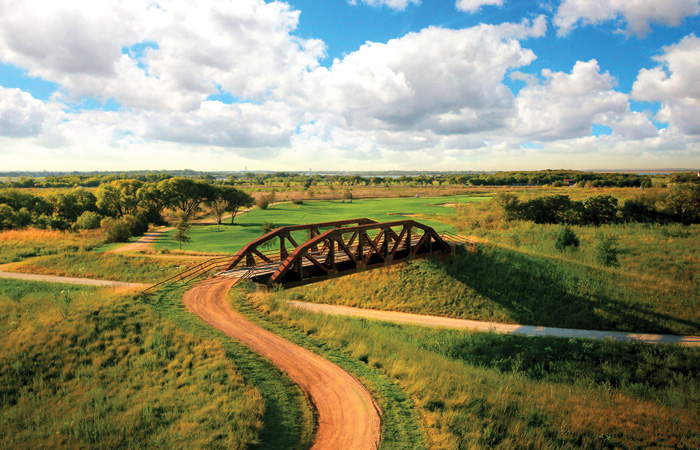When the LPGA comes to D-FW in September, the players will be met with a collection of holes that at one point or another, will require power, precision and creativity. This will be the second event at this Tripp Davis/Justin Leonard design and after last year’s tournament, a few changes are on the table for the second run. The staging area and all players will locker at The Tribute, which means there will be more room for hospitality areas and players to get ready for their rounds. Grandstands will be added around the area near the first green and second tee. However, the course will massage its routing to optimize it for spectators. The current No. 1 will serve as the 18th hole, and No. 2 will be the first hole of the tournament layout. This makes for a great place to watch as groups hit the tee or finish off their rounds.
As Old American prepares to host the LPGA event for the second time, AVIDGOLFER got a firsthand look at the course the world’s best will face this fall.

The first hole on this tough layout (which will play as the 18th during the LPGA event) is a dogleg that hugs water all down the left. Players that can send a draw right to left will chase the ball a bit further into the landing zone, but beware, there is a pot bunker in the middle of the fairway at about 270 yards that makes this a tough driving hole. Left of this bunker is a better position for back pin placements, and right of the trap is ideal for pins on the front portion of this slightly elevated green. One thing to be wary of at Old American are the shortened flagsticks. They can toy with your ability to judge distance and make the target appear farther away that it actually is, so you will need to trust the determined yardage.
No. 2 at Old American is another fairly straightforward par-4. Players who choose to cut the dogleg will have a shorter approach, but the risk of missing left can lead to an awkward angle of attack to the green, especially with a pin placement on the left. A tee shot that favors the right allows for more room, but players will then be looking at a longer iron effort into the putting surface.
The drive from the second green to the third tee spotlights one of the most interesting features of the property. The bridge players navigate in route to the third tee is a classic railroad bridge originally constructed in 1900 by Pencoyd Ironworks in Pennsylvania. After more than a century in its original location, the bridge was relocated to its current location. The bridge is a gorgeous addition to the course and fits seamlessly into its design.

The first par-5 of the round appears at No. 3. A well struck tee ball can find a speed slot at about 250 yards and can add some distance allowing players a reasonable chance to get home in two. The shorter players will need to pick a wedge number that is suitable and find a generous layup area. Be mindful of pin position if you plan to play this as a three-shot par-5 as a back right pin favors a layup shot on the left side of the fairway and pin placement on the left side will be simpler to attack from the right side of the layup zone.
The par-3 fourth hole is the first of a quartet of difficult par-3s at Ole American. This 178-yard hole faces back toward the south, which would generally be the direction of the prevailing winds, but in this peninsula of Lake Lewisville, the winds can be a bit tricky as they swirl off the water and around the golf course. Players need to be diligent in trying to pinpoint which direction they are moving shots. A shot to the middle of this putting surface is a great play here, as pins in the corners are difficult to access. A two-putt par is a great score on this tough par-3.
The fifth hole is a hard dogleg left that presents a unique scoring challenge. An aggressive line can leave longer hitters with nothing more than a short iron in, but tee shots that don’t cut off enough of the dogleg can run through the fairway and potentially be lost or find a deep fairway bunker. Choosing a more conservative route will leave a much longer approach and likely make a birdie unattainable.
No. 6 is another par-3 where judging the wind can be a bit tricky. The green sits only a stone’s throw from the water’s edge and the incoming winds can swirl as you choose a club for this 200-plus yard iron shot. A bunker short left can make for a near impossible up-and-down, so anything in the middle of the green is a success and a par is a great score.
Course architect Davis presents another unique challenge at the par-5 seventh hole. This dogleg right requires length and precision off the tee. Cutting a drive off the large fairway bunker is the ideal play, but those who don’t care to test the right side can bail out a bit left, but be wary, as anything too far down the left side can funnel out of the short-grass and into some very penal rough. Longer players can test the green in two, but a thin neck guarding the green can present a tough time chasing a shot onto the green. A bailout slightly right presents the optimal area for a pitch, and a good chance to notch a birdie or par.
The eighth hole is another par-3, that depending on the set of tees you choose, can be two completely different golf holes. From the back tees, this monster par-3 plays a hybrid-crushing 216 yards. If you choose a different set of tees, you could be playing from the right of a small group of trees, or it’s possible from some of the forward tee boxes you could be left of them. It’s a truly interesting hole that can be a totally different look depending on where you decide to put a tee in the ground.
No. 9 is one of the more interesting holes on the course from a routing standpoint. A long iron off the tee will leave players in an optimal position to an elevated green. Hit too much club off the tee and you run the risk of chasing the ball down into a hazard. A tee shot middle left of the fairway will catch the slope and run down the hill to a perfect position.
The 10th is a relatively tame par-4 considering how tough much of the rest of the course can be. A player that chooses to hit driver can cut some of the corner and have a scoring club into the green. A reasonable play is a long iron or hybrid short into the fairway, which will leave somewhere in the neighborhood of 150 yards remaining. As you make your way to the 10th green, take a second to stop and admire the wooden barn to the right. This structure was built in Central Michigan in the 1920’s and once served as hay storage for livestock. The barn was brought to Texas via semi-truck piece by piece and is now being used as cart storage.

No. 11, as with many other holes at OAGC, puts players to a decision on the tee. A drive down the left side leaves a much shorter approach, but brings trouble into play, while bailing out a bit right is the safe play, it can leave close to 200 yards left and make the visual of this infinity green and its cavernous greenside bunker more prevalent.
The 12th hole is another lengthy par-3, playing just a shade under 230 from the “Leonard” tees. As with most other holes on this property, your best miss is determined by pin position. If the pin is in the back, long and right is your best option, if the pin is middle or front, then short right is the optimal position to be. Players that can carve a cut shot to the middle of the green should get some help from the slope and end up with a makeable birdie effort, however, with a long iron in-hand, this is easier said than done.
No. 13 is a tough driving hole that depending on how aggressive you like to be, can yield dividends, or cause headaches. A tee shot that favors the left side leaves the best angle to the right side of the green, if the flag is tucked on the left, then it may be beneficial to lay back with a three-metal to preserve the best angle of attack from the right side of the fairway. Anything long and right of the putting surface can be borderline impossible to get up and down, so a miss short or long and left are the best options if you don’t find the green.
In my opinion, the 14th hole at Old American is the best hole on the property. A long par-5, this could be the watershed moment of the round. Birdies are gettable here with three good shots but spray it a bit and you can rapidly start tallying penalty strokes. If this hole is playing down wind, take an aggressive line over the bunker on the right, pull it off and the second shot plays significantly shorter. The second shot will be the main decision here, as a well struck ball off the tee will leave about 215 yards. Players that choose to lay-up need to select a side of the fairway based on where the pin is cut.
No. 15. features a bunker in the fairway about 290 yards off the tee, so players will need to avoid that to set themselves up for success at this 489-yard par-4. Play the approach shot a little long if the pin is tucked in the front of the green. A bailout to the right of the green isn’t a terrible pitch shot, but beware if the pin is on the right, as you could end up short sided.
As you make the turn for home at Old American, Davis and Leonard have constructed three of the more accessible holes on the golf course, beginning with the short par-4 16th. Playing just 346 from the tips, this hole is drivable for the longer hitters, or if you’re the type that likes to lay some coin on the round, this is an attackable press hole. Hit a good tee shot and you’ll be within’ flip wedge distance and have a legitimate shot at an easy birdie.

The par-3 17th is the shortest hole on the course, playing at just 154 yards. Again, this is a good opportunity to make up a shot with a well-placed iron shot. With a front pin position, a bit long to the middle of the green isn’t a bad spot to be. If the pin is in the back, be careful of flying the green and finding a short-sided chip.
The final hole at Old American is a fantastic par-5. At 551 yards from the back tees, a solid tee shot gives longer players the chance to attack this green in two, but if you lack confidence hitting a 3-wood or long iron, a layup to a good number isn’t a bad play. When the pin is tucked in the front left, consider taking an extra club to take the deep greenside bunker out of play.
Old American is undoubtedly one of the most interesting layouts in the Metroplex. Davis and Leonard have constructed a venue that can test the amateur and the professional alike. Over the last decade, a few changes and a couple of massive floods have softened the layout a bit to make it more enjoyable to play. For amateurs, choosing the proper tees is imperative, as this course can play as a monster if you bite off more than your game can chew. Be mindful of the wind when you arrive, as on a breezy day, your group might consider playing a tee or two forward to avoid a long and arduous day on the links, but for the player that truly knows how to manage their game, Old American is as stern a test as you’ll find in the area.
Old American Golf Club
Address: 1001 Lebanon Road
The Colony, TX 75056
Phone: 972.370.4653
Website: www.theoldamericangolfclub.com
Designers: Tripp Davis/Justin Leonard (2010)
Par/Yardage: 71/7,084 (Leonard tees), 6,829 (green tees), 6,713 (blue tees),
6,294 (white tees), 5,707 (gold tees), 5,186 (red tees)
Fairways: Premiere Bermuda
Greens: Mini-Verde
General Manager: Mike McCabe
Director of Golf: Cody Roye, PGA
Rates: Monday-Thursday $125.00
Friday-Sunday $150.00
Toughest Hole
No. 14, 571-yard par-5
While this is only listed as the No. 9 handicap on the course, for me, this one plays as a tough golf hole. The drive can be a bit awkward with the dogleg right. If you take off too much of the corner, you can be stymied, but not enough, and a well struck tee shot could chase through the fairway. Both power and precision are required off the tee, which can be tough to execute, especially on a day the wind is howling.
Favorite Holes
No’s 16, 17, 18
Instead of just one, I’m going to step outside the box here and give you my favorite holes. The trio of holes to finish at Old American are very unique. After doling out a tough three-plus hours, Davis and Leonard give players a legitimate chance to finish strong and walk away from the course with a good feeling. No. 16 is a short par-4, that for the longer players can even be drivable. No. 17 is the shortest par-3 on the property, and No. 18 is a gettable par-5. It’s not inconceivable for even a mid-level player to play these three in 2 or 3 under. It makes for a fun finish and is a great way to keep people coming back to Old American.
Most Intriguing Hole
No. 5 469-yard par-4
This hole presents an interesting tee shot that can quickly make or break your front-nine. Cut too much of the corner and you’re in trouble. Go through the fairway and you’re in trouble. Play it safe and lay back to the beginning of the dogleg, and you’ll be standing in the fairway with a mid or long iron in your hands. The bunkers short and right of the green make the approach visually intimidating for any right pin placement.